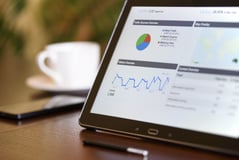Index Content
Web analytics is the process used to analyse information extracted from the user behaviour of a website. In this process, information is collected, measured, evaluated and thought about in order to understand and optimise its use. Here we expand on the knowledge and definition.
what are the 3 phases into which web analytics can be divided?
- Data collection, which must be consistent with each other, so it is best to group them under a single criterion.
- Measuring results: To do this, you must establish KPIs or key performance indicators, since what you want and intend to achieve is to define figures and compare them.
- Evaluation: This is the moment when we attribute value to something, e.g. conversion rate in the range of 2% to 4% is a positive indicator of customer satisfaction.
Once these three phases are completed, the most important thing is to understand the data obtained, and then look for a rational explanation that allows us to make effective decisions in our strategy.

The 6 main advantages of analysing your website
- Increased knowledge of the website. The information obtained allows you to find out which pages are most visited, the most read contents, the images or other elements that work best..
- Greater knowledge of the user: Knowing who is visiting your page and what contents interest them allows you to know their behaviour in order to know what to offer and how to reach them better.
- Generate new business opportunities. Web analytics can also give you clues to the most unexplored market niches.
- Reduce costs. Thanks to the optimisation of your actions, you will be able to improve the navigation of your website and save on costs invested in something that does not work or does not generate results.
- Boost your ROI, so you can see if you are getting the results you were expecting and what you should change in your campaigns.
- Optimisation of navigation flows, visibility and conversions. You will be able to know at what point in the conversion funnel your users abandon the page and, perhaps, with this data you can change and improve some functionalities.
Tools that help us to improve our web analytics
- Google Analytics is one of the most popular tools and any website owner can use it to analyse their site's traffic data.
- Google Search Console: This is a platform that mainly allows you to monitor and know the indexing status of a website and check the data of the search results.
- Woopra: Woopra allows you to analyse your website in real time by placing a tracking code that collects information about visitors and then reports it through the dashboard. It is a system oriented to the analysis and monitoring of small or medium-sized pages.
- SE Ranking: This tool is a cloud-based platform for SEO, as well as marketing professionals, which provides a series of tools for comprehensive website auditing, page ranking, competitor analysis, keyword analysis, etc.
- Awstats: Awstats is a tool created to generate statistical reports, especially about web traffic, analysing mainly email and server related aspects.
- SEMrush: This well-known SEO and web analytics tool allows you to monitor keywords and is essential for any marketing department. It provides information on organic searches, display advertising, incoming backlinks, paid searches and, in short, very useful information for SEM strategies.
- Moz is a software creation and development tool oriented towards SEO. Nowadays, it is not limited to simply understanding the Google search engine, but also tries to perfect the use of social networks, such as Twitter, Facebook or Instagram, and improve marketing.
- Ahrefs: Getting better rankings and more traffic can be made easier with Ahrefs. This tool allows you to perform basic functionalities such as optimising your website, analysing the competition, studying what your customers are searching for, learning from the top performing content in your industry and tracking your website's SEO progress.
- Hotjar generates heat maps that are very useful to know where the user is moving on the website.
- Piwik: This last tool is characterised by a very consistent privacy policy, which gives a lot of security to those companies that choose it to analyse their website data. It also offers very relevant information, such as the number of visits, the time spent on the website or the main keywords through which people arrive at your page.

We hope that you now have a good understanding of the definition, phases and advantages of web analytics, and we invite you to let us know if you are using any of the web analytics tools we have provided or if you have other tools in mind that we have not mentioned. Thank you for reading us!





